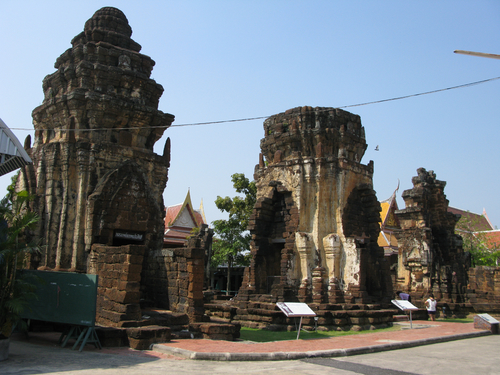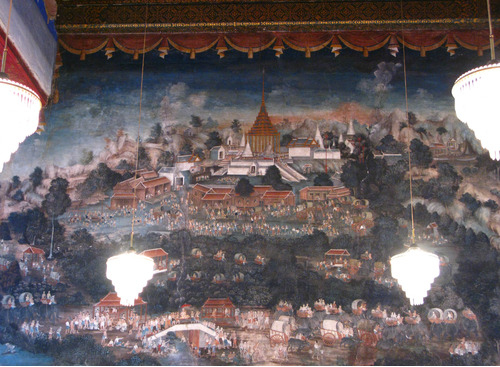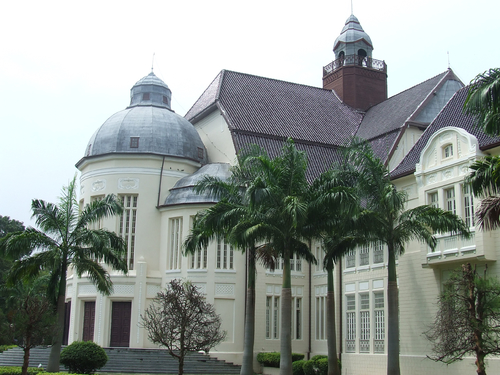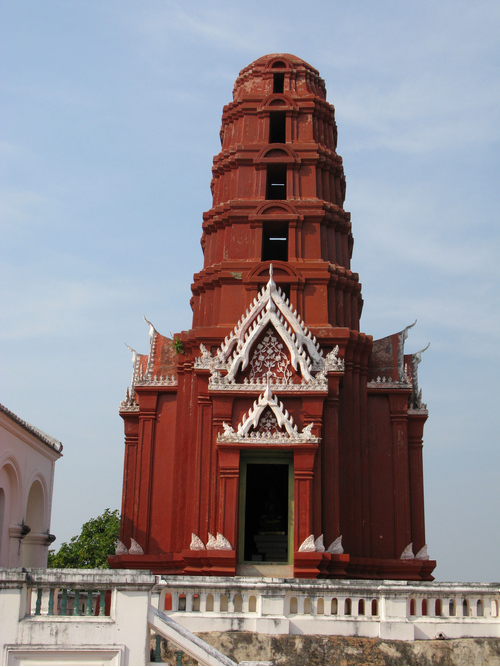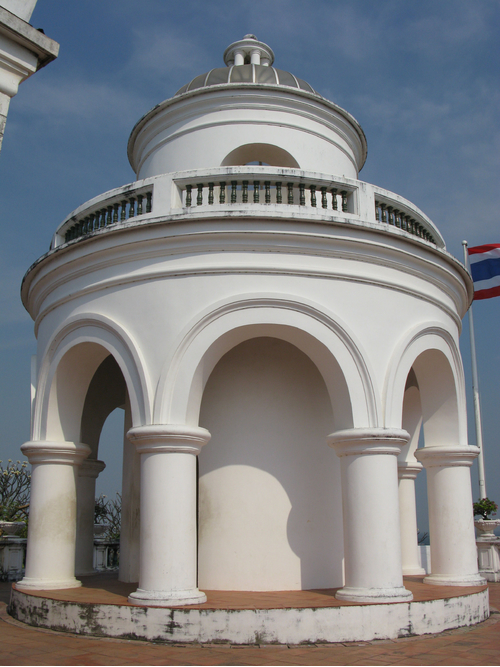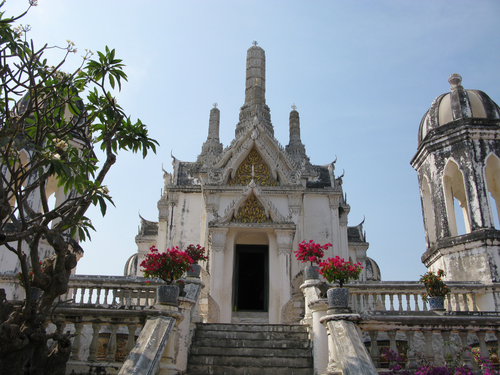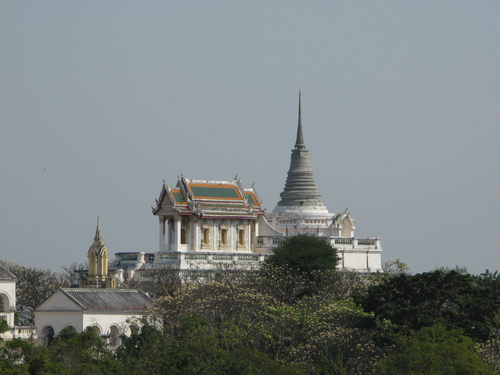Artwork Search
Arts in Southeast Asia Database
ArchitecturePrasat Kumpanglang
Prasat Kumpanglang is surrounded by a square laterite wall. It is facing east. Inside the laterite wall is the location of four laterite prasats in Khmer Arts. The 3 prasats in the front were arranged in a north-south line. The principle prasat is taller than the other two. This is similar to Prang Sam Yod in Lopburi.The fourth prasat is located behind the principle prasat on the east side. Stucco patterns appear on this prasat. In the front there is a gopura or an entrance. Inside the laterite wall on the eastern area appears a pond. Important artifacts that were found here are the radiant Avalokiteshvara Bodhisattva, the body part of the 4- arm Avalokiteshvara Bodhisattva, the body part of a Buddha image Sheltered by a Naga, and the head of Prachya Paramita. The use of laterite as the main material for the construction and the layout of the diagram displays the motto of the Buddhistic Triad. The northern prasat is Prachya Paramita, the central prasat is the Buddha image Sheltered by a Naga, and the southern prasat is Avalokiteshvara; the arrrangement of the idols like this is found in Mahayana Buddhism during the 18th century B.E. in the reign of King Jayavarman VII; therefore, the age of the site can be determined to be contemporary with King Jayavarman VII. The Preah Khan Inscription of Cambodia mentioned Mueang “Srichaiya Watcharapura” (Mueang Phetchaburi) that it was one of the six ancient Mueangs in the Central Region where one of 23 Pra Chaiya Buddha Mahanat had been sent from Mueang Phra Nakhon Luang to be enshrined in Mueang Phetchaburi. When compared to the ancient ruins, it can be confirmed that this Prasat Kumpanglang is the prasat mentioned in the inscription. Prasat Preah Khan is a prasat that is contemporary with King Jayavarman VII as well.
PaintingThe Wall Painting of The Pilgrimage to Phra Phutthabat, Saraburi
The powder color-painting depicted the Phra Phutthabat Mondop in the middle of the wall surrounding by other buildings and constructions in the temple. Under the Mondop is the depiction of people visiting the place by various methods such as by foot, by boat or by animal-drawn carriage. The people visiting Phra Phutthabat including both monks and villagers. The painting used the western-style technique of coloring with realistic shading and dimensions. Each parts used the bushes to separate them and to make the path for people to follow to the Mondop. The colors of the sky, clouds, and trees are realistic as in nature.
ArchitecturePhra Ram Ratchaniwet
Phra Ram Ratchaniwet is a two-storey Modern European style building with two tops and three porticos. Each portico has a large staircase, while the front portico in the east is in Rhenish Romanesque Trefoil plan. The entrance is in circular plan which is uncovered to the ceiling and has a large Jugendstil staircase that can only found here in Thailand. The central European courtyard is surrounded by the wings of the northern part. The building uses clay roof tiles, while the interior decoration use copper, stained glass, coloured tiles, iron and chandeliers.
ArchitecturePhra Prang Daeng
Phra Prang Daeng is a prasat-typed stupa in cross plan whose tiered pediment in the portico of four directions are built according to traditional Thai style. The influence of Khmer Art shows through five pyramidal plump chambers and the principal edges which are increased. Furthermore, Each doorway has two pilasters and one architrave. Although, the elements on the top are not decorated as same as Khmer prasat, the framework still shares the similar character. The construction is also related to the western technic of true-arched building and using bricks for the top instead of stones.
ArchitectureHo Jajavalaviangjaya
Ho Jajavalaviangjaya is a two-storey tower in circular plan which shares the feature of the 16th century tower in Europe. There are 8 round pillars and arcade wall supporting the framework. A spiral iron staircase leads to the upper veranda. A large dome on the top is tranparent with clear glasses. Above the dome, there is a small brick-and-stucco lighthouse with round purlin and crossing supporting ironframe.
ArchitectureVejyanvijiarnprasat Pavilion
Vejyanvijiarnprasat Pavilion is a brick-and-stucco building in cross plan with five prang-typed tops; the highest on the building and four smaller on the proticos. There is a Nobhasula on each top. The stucco decaration can be found on the pediment, echinus and pilasters. The construction used pointed-arched technic, which narrow doorways can support its rooftop.
ArchitectureWat Phra Kaew Noi
Phra Ubosot of Wat Phra Kaew Noi is a traditional Thai marble building in rectangular plan. The pediment displays Phra Mongkut on Phan Waenfah surrounded by two five-tiered parasols and Petchaburi floral pattern at the back. The wall painting shows floral pattern, while the windows and doorways are decorated with stucco figures. The duplicated Phra Nirantarai and the duplicated Emerald Buddha are installed inside the ubosot. Phra Sudhaselachedi is a bell-shaped marble stupa at the back of the ubosot which can be reached by the corridor to the veranda. The marble was cut from Koh Sichang, Chonburi by the order of King Rama IV. He also store the buddha relics inside the stupa.
